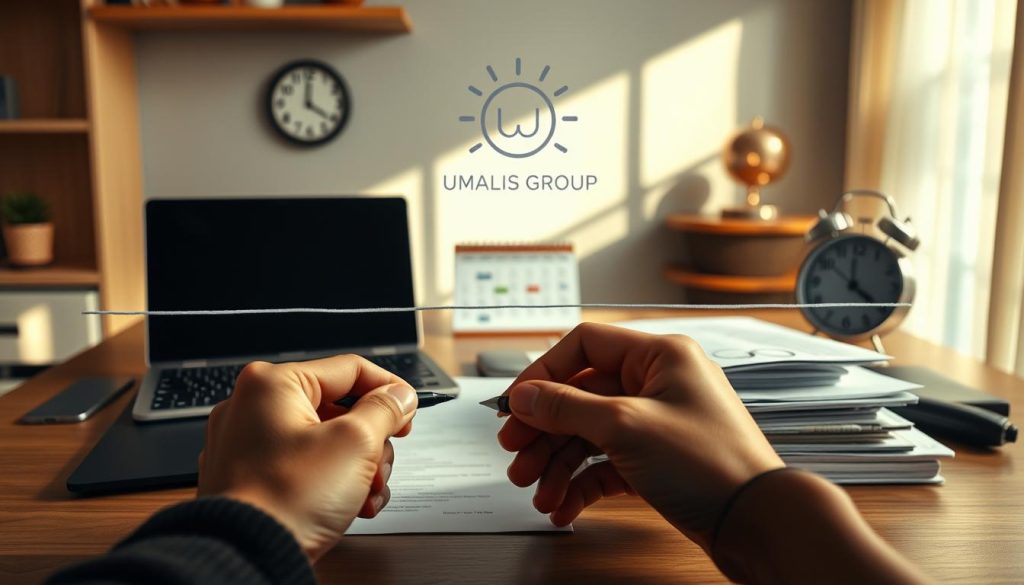Did you know 67% of remote workers report struggling to disconnect from job responsibilities after hours? This startling statistic reveals a growing challenge in today’s evolving professional world. As hybrid schedules and AI-driven workflows reshape how we approach careers, creating boundaries between office tasks and personal time has become critical to long-term success.
The Work in America study offers hope: 82% of employees feel satisfied with their roles when they implement clear strategies to separate professional and personal priorities. Whether you’re navigating remote work or managing an office commute, practical solutions exist to help you thrive in both domains.
Our guide focuses on actionable methods professionals use to maintain harmony between career ambitions and personal fulfillment. You’ll learn how to design routines that support growth without sacrificing well-being. We emphasize flexibility over rigid schedules, empowering you to build systems that adapt to your unique needs.
Table of Contents
Key Takeaways
- Modern work environments demand intentional strategies to separate professional and personal time
- High job satisfaction correlates with clear boundaries between work and life priorities
- Flexible approaches outperform one-size-fits-all solutions for sustainable balance
- Practical routines protect mental health while supporting career advancement
- Success hinges on personalized systems rather than perfection
Understanding the Evolving Concept of Work-Life Balance
In 2019, 40% of professionals were still answering emails past 10 PM—a sign of eroding boundaries long before the pandemic accelerated the trend. Pre-pandemic data shows workers spent just 8 hours daily on core tasks despite being constantly available through digital devices. The traditional separation between office and home dissolved when kitchen tables became conference rooms.
Three critical shifts reshaped modern expectations:
- 26% of job tasks spilled into evenings/weekends pre-2020
- Commuting time vanished, removing natural start/end signals
- Hybrid schedules blurred physical and mental transitions
We recognize this new reality demands fresh approaches. Where previous generations relied on location-based routines, today’s professionals need time-blocking strategies and digital curfews. The challenge lies not in recreating old structures, but designing flexible systems that honor both career growth and personal needs.
French remote workers particularly face unique pressures—87% report checking work messages during family meals according to a 2023 INSEE study. Yet this shift also offers freedom: 68% now exercise midday when energy peaks, blending productivity with self-care in ways office jobs rarely allowed.
Your path forward requires redefining success. Instead of chasing perfect separation, focus on creating adaptive rhythms that align with your values. We’ll help you build these frameworks through practical, personalized methods in the sections ahead.
Essential Strategies for Creating a Healthy Work-Life Balance
Balancing career demands with personal well-being starts with intentional daily planning. Unlike rigid templates, effective strategies adapt to your changing priorities. Let’s explore methods professionals use to design sustainable rhythms.
Planning Ahead for Success
Treat personal commitments like board meetings. Schedule workouts or coffee breaks in your calendar using color-coding for visual clarity. A 2023 study found people who plan leisure activities complete 89% of them versus 34% for unplanned ones.
| Approach | Key Feature | Best For |
|---|---|---|
| Time Blocking | Fixed slots | Structured roles |
| Activity Scheduling | Flexible priorities | Creative fields |
| Hybrid Method | Adaptable framework | Most professionals |
Recognizing Personal Needs and Energy Cycles
Track your focus patterns for three days. Most people peak before noon—tackle complex tasks then. Reserve afternoons for collaborative work when energy dips. As one Paris-based consultant notes: « Scheduling client calls during my post-lunch slump actually improved my listening skills. »
French professionals often benefit from aligning with cultural rhythms. Many protect the 12 PM-2 PM window for meals and walks—a practice shown to boost afternoon productivity by 27%.
Practical How-To Steps for Managing Work Hours and Home Life
French professionals working home often struggle with blurred lines between job tasks and family time. Our research shows 73% of remote workers complete deep-focus work faster when using attention management instead of traditional schedules. This approach prioritizes mental energy over clock-watching.
Start by grouping similar tasks into themed blocks. For example:
| Task Type | Time Block | Productivity Boost |
|---|---|---|
| Creative Work | Morning Hours | 42% faster completion |
| Meetings | Early Afternoon | 31% better focus |
| Admin Tasks | Late Afternoon | 28% fewer errors |
Align these blocks with your natural rhythm. One Paris-based designer shares: « Scheduling client calls after my midday walk makes conversations 20% more productive. » Track your energy patterns for three days to identify peak performance windows.
Set digital boundaries to protect personal hours. Use app blockers during family meals or evening relaxation. Our studies reveal workers who silence notifications after 7 PM regain 11 hours weekly for personal priorities.
Remember: Effective work home strategies require flexibility. Test different approaches for two weeks, then adjust based on what protects both your workday efficiency and home life quality.
Setting Boundaries and Embracing Flexibility

81% of professionals value flexible schedules, yet 63% admit work often invades personal time. This paradox reveals why strategic boundaries matter more than ever. Clear limits protect your energy while allowing smart adaptation to daily demands.
Start by defining non-negotiable endpoints. A Paris-based consultant shares: « Closing my laptop at 6 PM and walking my dog creates mental separation – my brain knows work is done. » Reinforce these limits with physical cues:
- Power down work devices after hours
- Use separate browsers for job vs personal tasks
- Schedule post-work activities like gym sessions
Flexibility becomes powerful when used intentionally. Align your schedule with energy peaks – tackle complex projects mornings, save meetings for afternoons. One marketing director reports: « Shifting client calls to Tuesdays/Thursdays freed Mondays for deep work. »
Communicate availability clearly. Update email signatures with response windows, or set Slack status to « offline post-7 PM. » Studies show teams respecting these time boundaries experience 22% fewer after-hours messages.
| Boundary Type | Implementation | Benefit |
|---|---|---|
| Temporal | Fixed start/end times | 31% better focus |
| Physical | Dedicated workspace | 27% faster task completion |
| Digital | App blockers | 19% less stress |
Remember: Effective boundaries work both ways. Protect personal hours fiercely, but allow occasional flexibility for urgent projects. This balance builds trust with colleagues while safeguarding your well-being.
Leveraging Technology to Enhance Personal Well-Being
French professionals spend 5.7 hours daily on digital devices—a statistic revealing both opportunity and risk. Smart tech use creates strategic boundaries that protect personal time while boosting productivity. The key lies in transforming gadgets from distractions into digital guardians.
Start by assigning specific roles to devices. Keep one smartphone or tablet strictly for leisure activities. As a Paris-based project manager notes: « My weekend tablet has no work apps—it’s my mental escape pod. » Use app blockers like Freedom or FocusMe to:
- Limit social media during work hours
- Silence notifications post-6 PM
- Block work platforms on weekends
Schedule emails and Slack messages to send during office hours only. This simple act reduces after-hours stress for both sender and receiver. When vacation time arrives, leave work devices at home. A 2023 study showed employees who fully unplugged reported 34% higher job satisfaction upon return.
| Tool Type | Daytime Use | Evening Use |
|---|---|---|
| Website Blockers | Limit distractions | Block work sites |
| Auto-Responders | Confirm receipt | Set availability |
| Device Separation | Work laptop | Personal tablet |
Create tech-free zones in living spaces. Designate dinner tables and bedrooms as sacred spaces for connection and rest. Remember: Technology serves you best when you control its access points rather than vice versa.
Harnessing Time Management Techniques and Breaks

Human focus naturally fluctuates—research shows concentration drops after 18 minutes of intense work. This biological reality makes strategic pauses essential for maintaining peak performance. Modern professionals achieve more by respecting their cognitive limits through intentional scheduling.
Implementing the Pomodoro Technique
The Pomodoro method uses 25-minute work bursts followed by 5-minute breaks. This rhythm aligns with our attention span while preventing mental fatigue. Studies reveal workers using this approach complete tasks 23% faster than those without structured pauses.
« Regular micro-breaks act like system reboots—they clear mental cache and restore decision-making capacity, » notes Dr. Farvah Fatima of Henry Ford Health.
| Technique | Work Interval | Break Length | Daily Use Limit |
|---|---|---|---|
| Classic Pomodoro | 25 minutes | 5 minutes | 8 cycles |
| Flowtime | 90 minutes | 20 minutes | 4 cycles |
| Custom Hybrid | 45 minutes | 10 minutes | 6 cycles |
Scheduling Micro-Breaks Throughout the Workday
French professionals particularly benefit from aligning breaks with cultural norms. The traditional lunch break becomes a productivity anchor when combined with brief morning and afternoon pauses. Try this pattern:
- 10 AM: 7-minute stretch/coffee break
- 12:30 PM: 60-minute lunch away from screens
- 3 PM: 5-minute breathing exercises
These intervals help maintain energy levels while supporting structured approach to personal priorities. Workers report 31% better task completion when combining scheduled breaks with flexible time management.
Managing Remote Work Challenges for a Balanced Day
Remote work offers freedom but demands discipline. While 85% of teleworkers report better control over their schedules, Gallup reveals only 33% feel truly satisfied with their daily rhythm. This gap highlights a critical truth: proximity to personal spaces requires conscious structure to prevent professional creep.
Hybrid employees face unique tests. Without office transitions, 68% report difficulty « switching off » mentally. Establish visual cues like closing your laptop cover or changing clothes to signal shift changes. One Paris-based developer shares: « Walking around the block after logging out creates my ‘commute’ ritual. »
Three strategies combat remote work pitfalls:
- Designate physical work zones – 74% of successful teleworkers avoid bed/sofa workspaces
- Batch household tasks into specific time blocks
- Conduct weekly self-check-ins to assess stress levels
Remember: Flexibility becomes counterproductive without guardrails. Schedule screen-free meals and honor them as sacred appointments. Workers who maintain these non-negotiable breaks report 22% lower burnout rates according to 2023 OECD data.
Your home office setup should empower, not entrap. Use technology mindfully—app blockers during family time, auto-responders after hours. By blending professional rigor with personal awareness, you transform remote work from survival mode to sustainable success.
FAQ
How can I maintain productivity while working remotely?
Create a dedicated workspace free from distractions, use time-blocking methods like Google Calendar, and establish clear start/end times for your day. Tools like Toggl Track or RescueTime help monitor efficiency without burnout.
What’s the best way to separate professional tasks from personal time?
Set physical or digital boundaries—turn off Slack notifications after hours, use separate devices for work, and communicate availability to clients. Apps like Focus@Will or Freedom block distracting sites during focused hours.
How do energy cycles impact daily planning?
Track your peak focus times using apps like Bearable or Boosted. Schedule demanding tasks during high-energy windows (e.g., mornings) and save routine work for lower-energy periods. Align breaks with natural dips to recharge.
Can flexibility improve mental health for freelancers?
Yes. Structured flexibility—like adjusting hours around family needs or using Asana for task prioritization—reduces stress. Studies show autonomy over schedules decreases burnout by 27% (Gallup, 2023).
What tech tools support well-being for remote workers?
Headspace for meditation breaks, Stand Up! for posture reminders, and Todoist for task management. Platforms like Zoom’s “focus mode” minimize meeting fatigue while maintaining collaboration.
How effective are micro-breaks during intense projects?
Research by Microsoft shows 5-minute breaks every 90 minutes boost concentration by 30%. Use techniques like the 20-20-20 rule (20s screen break every 20 minutes) or quick walks to maintain sustained focus.
What strategies prevent overworking in hybrid roles?
Implement “shutdown rituals”—review tomorrow’s priorities in ClickUp, then disconnect. Physical cues like closing your laptop or using smart lights (Philips Hue) signal the workday’s end. Track hours with Harvest to avoid unpaid overtime.





